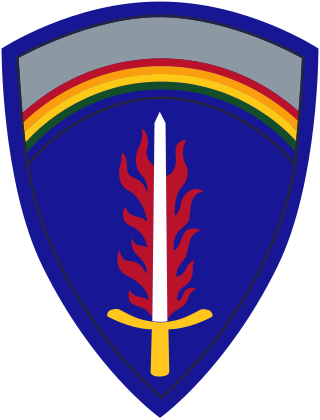
A paratrooper or military parachutist is a soldier trained to conduct military operations by parachuting directly into an area of operations, usually as part of a large airborne forces unit. Traditionally paratroopers fight only as light infantry armed with small arms and light weapons, although some paratroopers can also function as artillerymen or mechanized infantry by utilizing field guns, infantry fighting vehicles and light tanks that are often used in surprise attacks to seize strategic positions behind enemy lines such as airfields, bridges and major roads.

British Army of the Rhine (BAOR) was the name given to British Army occupation forces in the Rhineland, West Germany, after the First and Second World Wars, and during the Cold War, becoming part of NATO's Northern Army Group (NORTHAG) tasked with defending the North German Plain from the armies of the Warsaw Pact. The BAOR constituted the bulk of British forces in West Germany, and was a part of British Forces Germany (BFG). British Forces Germany consisted of elements of the three service branches of the British Armed Forces based in West Germany; BAOR controlled Army units stationed there.

The 1st Airborne Division was an airborne infantry division of the British Army during the Second World War. The division was formed in late 1941 during the Second World War, after the British Prime Minister, Winston Churchill, demanded an airborne force, and was initially under command of Major General Frederick A. M. "Boy" Browning. The division was one of two airborne divisions raised by the British Army during the war, with the other being the 6th Airborne Division, created in May 1943, using former units of the 1st Airborne Division.

The Norwegian Army is the land warfare service branch of the Norwegian Armed Forces. The Army is the oldest of the Norwegian service branches, established as a modern military organization under the command of the King of Norway in 1628. The Army participated in various continental wars during the 17th, 18th, and 19th centuries as well, both in Norway and abroad, especially in World War II (1939–1945). It constitutes part of the Norwegian military contribution as a charter member of the North Atlantic Treaty Organization (NATO) since 1949.

Brigade Nord is the major combat formation and only brigade of the Norwegian Army, consisting of eight battalions and one military police company. It is mostly based in mid-Troms north of the Arctic Circle.

In military organizations, a pathfinder is a specialized soldier inserted or dropped into place in order to set up and operate drop zones, pickup zones, and helicopter landing sites for airborne operations, air resupply operations, or other air operations in support of the ground unit commander. Pathfinders first appeared in World War II, and continue to serve an important role in today's modern armed forces, providing commanders with the option of flexibly employing air assets. There was a group of pilots who were also designated pathfinders. They flew C-47 (DC-3) aircraft and were the lead planes followed by paratroop transports, used for dropping paratroopers into designate drop zones such as on D-Day, the Normandy Invasion.

The occupation of Norway by Nazi Germany during the Second World War began on 9 April 1940 after Operation Weserübung. Conventional armed resistance to the German invasion ended on 10 June 1940, and Nazi Germany controlled Norway until the capitulation of German forces in Europe on 8 May 1945. Throughout this period, a pro-German government named Den nasjonale regjering ruled Norway, while the Norwegian king Haakon VII and the prewar government escaped to London, where they formed a government in exile. Civil rule was effectively assumed by the Reichskommissariat Norwegen, which acted in collaboration with the pro-German puppet government. This period of military occupation is, in Norway, referred to as the "war years", "occupation period" or simply "the war".
A battlegroup or task force in modern military theory is the basic building block of an army's fighting force. A battlegroup is formed around an infantry battalion or armoured regiment, which is usually commanded by a lieutenant colonel. The battalion or regiment also provides the command and staff element of a battlegroup, which is complemented with an appropriate mix of armour, infantry, and support personnel and weaponry relevant to the task it is expected to perform.

The entirety of Germany was occupied and administered by the Allies of World War II, from the Berlin Declaration on 5 June 1945 to the establishment of West Germany on 23 May 1949. Unlike occupied Japan, Nazi Germany was stripped of its sovereignty and former state: after Germany formally surrendered on 8 May 1945, the four countries representing the Allies asserted joint authority and sovereignty through the Allied Control Council (ACC).

The Independent Norwegian Brigade Group in Germany was a Norwegian expeditionary force stationed in the British zone of Allied-occupied Germany, from 1946 to 1953. At first it was based in the Hanover area and from 1948 to 1953 in the Schleswig-Holstein area of Germany as part of the British occupying force after World War II.

The 61st Infantry Division was an infantry division of the British Army, raised in 1939 as part of the expansion of the Territorial Army in response to the German occupation of Czechoslovakia. The division was created as a duplicate of the 48th Infantry Division, and was assigned to home defence duties.

The 2nd Parachute Brigade was an airborne forces brigade formed by the British Army during the Second World War.

The 1st Airlanding Brigade was an airborne infantry brigade of the British Army during the Second World War and the only glider infantry formation assigned to the 1st Airborne Division, serving alongside the 1st Parachute Brigade and 4th Parachute Brigade.

The Polish Armed Forces in the West refers to the Polish military formations formed to fight alongside the Western Allies against Nazi Germany and its allies during World War II. Polish forces were also raised within Soviet territories; these were the Polish Armed Forces in the East.

The Occupation of the Rhineland placed the region of Germany west of the Rhine river and four bridgeheads to its east under the control of the victorious Allies of World War I from 1 December 1918 until 30 June 1930. The occupation was imposed and regulated by articles in the Armistice of 11 November 1918, the Treaty of Versailles and the parallel agreement on the Rhineland occupation signed at the same time as the Versailles Treaty. The Rhineland was demilitarised, as was an area stretching fifty kilometres east of the Rhine, and put under the control of the Inter-Allied Rhineland High Commission, which was led by a French commissioner and had one member each from Belgium, Great Britain and the United States. The purpose of the occupation was to give France and Belgium security against any future German attack and serve as a guarantee for Germany's reparations obligations. After Germany fell behind on its payments in 1922, the occupation was expanded to include the industrial Ruhr valley from 1923 to 1925.

In Operation Doomsday, the British 1st Airborne Division acted as a police and military force during the Allied occupation of Norway in May 1945, immediately after the victory in Europe during the Second World War. The division maintained law and order until the arrival of the remainder of Force 134, the occupation force. During its time in Norway, the division was tasked with supervising the surrender of the German forces in Norway, as well as preventing the sabotage of vital military and civilian facilities.

No. 10 (Inter-Allied) Commando was a commando unit of the British Army during the Second World War, recruited largely from non-British personnel from German-occupied Europe. This unit was used to help co-ordinate attacks with other Allied forces.

The 1st Airlanding Light Regiment was an airborne forces unit of the British Army's Royal Artillery during the Second World War.

United States Army Europe and Africa (USAREUR-AF) is an Army Service Component Command (ASCC) /Theater Army responsible for directing United States Army operations throughout the U.S. European Command (EUCOM) and U.S. Africa Command (AFRICOM) area of responsibility.
France was one of the largest military powers to come under occupation as part of the Western Front in World War II. The Western Front was a military theatre of World War II encompassing Denmark, Norway, Luxembourg, Belgium, the Netherlands, the United Kingdom, France, Italy, and Germany. The Western Front was marked by two phases of large-scale combat operations.

















